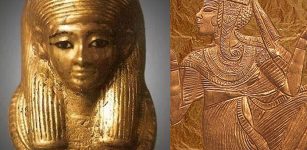Pazyryk Carpet Found In Scythian Tomb Considered The Oldest Carpet In The World
A. Sutherland - AncientPages.com - In 1949, Russian archeologist Sergei Rudenko made an extraordinary discovery while excavating burial mounds and a Scythian prince's tomb in southern Siberia.
 Pazyryk Carpet. Image source
Pazyryk Carpet. Image source
The place of the discovery was the so-called Pazyryk Valley, Altai Territory, in the region of the Bolshoy Ulagan River. In his excavations, Rudenko focused on the ancient history of weaving.
The tomb of a Scythian Prince dating back to 500 B.C. contained many treasures, and among them was the Pazyryk Carpet, measuring 183cm x 200cm and made by skilled craftsmen. It was created by using the traditional Turkish knotting system. The ancient rug is finely knotted with an average of 200 to 270 symmetrical knots to the square inch.
The tradition of making this kind of carpet originated from the nomadic Turkish tribes that occupied central Asia two millennia ago. However, this unbroken tradition of rug-making survived alongside more modern practices.
The carpet's decoration is vibrant and varied. The central part is covered with 24 cross-shaped figures, each consisting of 4 stylized lotus buds. This composition is framed by a border of griffins, followed by another one of 24 fallow deer. The most expansive of these two borders contains 28 figures of men on horseback and dismounted.
Credit: Hermitage Museum - Public Domain
Naturally, the carpet's once bright yellows, blues, and reds are not visible today, but initially, the rug must have displayed a beautifully glowing range of colors.
The Pazyryk carpet was made using the technique of the symmetrical double knot, the so-called Turkish knot, which means - 3600 knots per 1 dm2, so the whole carpet has more than 1,250,000 knots, and therefore this carpet pile is dense.
The origin of this unique Pazyryk carpet is not entirely known. Experts suggest that it may have a connection to Iran, but it perhaps was made somewhere in Central Asia thanks to the contacts of ancient people of the Altai Mountains with those from Iran and the Near East region.
Interestingly, the beautiful Pazyryk rug may represent only a copy of the original Persian piece of art.
The Pazyryk culture was a Scythian nomadic Iron Age archaeological culture of Iranian origin that lived from the 6th to 3rd centuries BC. Unearthed artifacts and mummified humans found in the Siberian permafrost in the Altay (Altai) Mountains, Kazakhstan, and Mongolia made their identification possible.
Another Pazyryk rug. Circa 400 BC. Hermitage Museum - Image source - Schreiber - Public Domain
The Pazyryk's mummies were buried in long barrows (or kurgans), similar to the Scythian tomb mounds in Ukraine. Many artifacts and human remains were found at this location.
The culture flourished and benefited from the many trade routes and caravans of merchants passing through the area.
Ancient cultures flourished and disappeared for thousands of years in the Altai region, Siberia. Archaeologists have excavated the old burial complexes of the Pazyryk culture that existed in the Altai region about 2,500 years ago, from the end of 600 BC to the beginning of 200 BC.
Excavations revealed several skulls that offer evidence of sophisticated ancient surgical technologies and tombs with the bodies of horses and one with an embalmed body of a man whose body was decorated with tattoos depicting animal motifs. The remarkable textiles recovered from the Pazyryk burial tombs include the Pazyryk Carpet, pieces of woven Persian fabric, and the oldest embroidered Chinese silk.
Updated on May 11, 2024
Written by – A. Sutherland - AncientPages.com Senior Staff Writer
Copyright © AncientPages.com All rights reserved. This material may not be published, broadcast, rewritten or redistributed in whole or part without the express written permission of AncientPages.com
Expand for referencesMore From Ancient Pages
-
 On This Day In History: Count Leo Tolstoy Was Censored – On Feb 20, 1901
News | Feb 20, 2017
On This Day In History: Count Leo Tolstoy Was Censored – On Feb 20, 1901
News | Feb 20, 2017 -
 Ancient DNA Study Reveals Surprise About Britain’s Bronze Age – What Happened On The Orkney Islands?
DNA | Mar 31, 2022
Ancient DNA Study Reveals Surprise About Britain’s Bronze Age – What Happened On The Orkney Islands?
DNA | Mar 31, 2022 -
 Ancient Human Traces Found In The Inhospitable Namib Desert
Human Beginnings | Oct 21, 2024
Ancient Human Traces Found In The Inhospitable Namib Desert
Human Beginnings | Oct 21, 2024 -
 Longvek – Ancient Historical City That Sheds Light On Cambodia’s ‘Dark Age’
Archaeology | Jan 13, 2016
Longvek – Ancient Historical City That Sheds Light On Cambodia’s ‘Dark Age’
Archaeology | Jan 13, 2016 -
 Giant Balor Of The Evil Eye – Terrifying Fomorian King And Grandfather Of Celtic God Lugh
Celtic Mythology | Apr 30, 2018
Giant Balor Of The Evil Eye – Terrifying Fomorian King And Grandfather Of Celtic God Lugh
Celtic Mythology | Apr 30, 2018 -
 World’s Oldest Hand And Footprints Discovered On The Tibetan Plateau Are 226,000-Year-Old!
Archaeology | Sep 15, 2021
World’s Oldest Hand And Footprints Discovered On The Tibetan Plateau Are 226,000-Year-Old!
Archaeology | Sep 15, 2021 -
 5,000-Year-Old Mystery: Decoration Of Eggs Predates Our Easter Tradition
Archaeology | Apr 9, 2020
5,000-Year-Old Mystery: Decoration Of Eggs Predates Our Easter Tradition
Archaeology | Apr 9, 2020 -
 Griffins Were Mythical Gold-Guarding Hybrid Creatures Known For At Least 5,000 Years
Ancient Symbols | Mar 9, 2021
Griffins Were Mythical Gold-Guarding Hybrid Creatures Known For At Least 5,000 Years
Ancient Symbols | Mar 9, 2021 -
 Rare Ancient Caribbean Skull Shows Evidence Of Leprosy
Archaeology | Nov 29, 2021
Rare Ancient Caribbean Skull Shows Evidence Of Leprosy
Archaeology | Nov 29, 2021 -
 Unique Purbeck Marble Found On England’s Oldest Historic Shipwreck
Archaeology | Jun 14, 2024
Unique Purbeck Marble Found On England’s Oldest Historic Shipwreck
Archaeology | Jun 14, 2024 -
 Nail Polish Was Used In 3,000 B.C. – Color Of Fingernails Indicated Social Status In Ancient China And Egypt
Ancient History Facts | Jan 11, 2018
Nail Polish Was Used In 3,000 B.C. – Color Of Fingernails Indicated Social Status In Ancient China And Egypt
Ancient History Facts | Jan 11, 2018 -
 Lofn ‘Matchmaker’ – Norse Goddess Of Forbidden Marriages Of People Who Wish To Be Loved And Search For Partners
Featured Stories | Mar 25, 2021
Lofn ‘Matchmaker’ – Norse Goddess Of Forbidden Marriages Of People Who Wish To Be Loved And Search For Partners
Featured Stories | Mar 25, 2021 -
 How Far South Did Prehistoric Highly Skilled Polynesian Seafarers Sail?
Archaeology | Nov 1, 2024
How Far South Did Prehistoric Highly Skilled Polynesian Seafarers Sail?
Archaeology | Nov 1, 2024 -
 Evidence For A Divergence Between Eastern And Western Mediterranean Indo-European Languages Finally Provided By Ancient Genomics Study
Archaeology | Jan 4, 2025
Evidence For A Divergence Between Eastern And Western Mediterranean Indo-European Languages Finally Provided By Ancient Genomics Study
Archaeology | Jan 4, 2025 -
 Hidden Byzantine Hoard Offers Evidence Of A Dramatic Historial Event In The Levant
Artifacts | Oct 13, 2022
Hidden Byzantine Hoard Offers Evidence Of A Dramatic Historial Event In The Levant
Artifacts | Oct 13, 2022 -
 Early Homo Sapiens From Southeast Asia Could Adapt To A Rainforest Environment
Archaeology | Oct 17, 2021
Early Homo Sapiens From Southeast Asia Could Adapt To A Rainforest Environment
Archaeology | Oct 17, 2021 -
 Baffling Cathar Mystery – Was It A Double Ancient Reincarnation Case?
Featured Stories | Jan 12, 2025
Baffling Cathar Mystery – Was It A Double Ancient Reincarnation Case?
Featured Stories | Jan 12, 2025 -
 Dozens Of Giant ‘Lost’ Nazca Geoglyphs Unearthed By Drones In Peru
Archaeology | Apr 7, 2018
Dozens Of Giant ‘Lost’ Nazca Geoglyphs Unearthed By Drones In Peru
Archaeology | Apr 7, 2018 -
 Cog Stones – Unusual Stone Discs Made By An Ancient Lost Civilization In California
Artifacts | Jan 4, 2018
Cog Stones – Unusual Stone Discs Made By An Ancient Lost Civilization In California
Artifacts | Jan 4, 2018 -
 Mystery Of Dakhamunzu And The Zannanza Affair – Was Queen Ankhesenamun Hiding Her Identity?
Featured Stories | Feb 1, 2019
Mystery Of Dakhamunzu And The Zannanza Affair – Was Queen Ankhesenamun Hiding Her Identity?
Featured Stories | Feb 1, 2019


